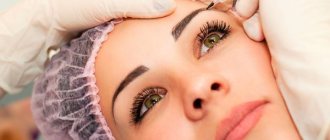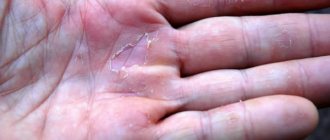Hair structure
To understand the action of a photoepilator, it will be useful to consider the structure of human hair. It has visible and hidden parts.
- The visible part is the rod.
- The part that is under the skin is the hair follicle or root.
The bulb is equipped with a sac - a follicle. In its lower part there is a papilla, consisting of blood vessels and connective tissue. He “manages” the condition and growth of the hair. When the papilla dies, the hair as a whole dies. If the papilla remains alive after some adverse effect, but the hair is dead, then the papilla gives life to a new one.
The visible part of the hair has three layers:
- Internal - the medulla through which nutrition is supplied;
- External – cuticle – protects hair;
- Cortex is the layer between the inner and outer layers.
Cortex is dead cells that give hair elasticity and strength. The cortex contains melanin, the pigment that determines hair color. Melanin is also present in the follicles.
Design of the photoepilator working handpiece.
Light flashes are produced through the working spot of the handpiece - the working part, which is a handle - on one of the planes of which there is a contact area, which is the face of a prism that focuses the light. Inside the handpiece there is an intense light source - a xenon lamp. It is a consumable material, i.e., like any consumable material, a xenon lamp has its own resource - a predetermined number of flashes that it can produce. The average service life of a xenon lamp depends on the type of photoepilator or the intensity of the flashes. The lamp can produce from 90,000 to 300,000 flashes, depending on the type of operation of the device.
Since a lot of thermal energy is generated when working with a photoepilator, for a comfortable procedure for the client, any photoepilator is equipped with an effective semiconductor prism cooling system, which operates through the use of semiconductor elements called Peltier. It allows you to lower the temperature of the prism to -10 °C in 3 minutes, which eliminates any pain. Thus, the procedure becomes as comfortable and safe as possible for the client.
To ensure the operation of the cooling system, only distilled water is used, since only the use of such water guarantees that the cooling system will not become clogged or fail due to the elements contained in the water. In addition to clogging the cooling system of the photoepilator, it is highly likely that immediately after using salt water, a salt film will form on the xenon lamp, impairing the transmission of light energy. A prerequisite for using a photoepilator is to change the water once a month.
Training to use a photoepilator
The effectiveness of the procedures depends on several factors: a sufficient number of procedures within the course, if necessary, repeating the course after a certain time, a hair type suitable for photoepilation, adequate preliminary consultation and subsequent assessment of the results obtained by a qualified cosmetologist , etc.
The essence of the photoepilation method
- Photoepilation is a method of removing hair by exposure to high-pulse light. It is based on the ability of melanin, located in the hair shaft and its pigment follicle, to absorb light waves. The photoepilator acts on the blood in the capillaries that feed the bulb through heat waves. As a result of this effect, the blood coagulates, and the follicle, not receiving nutrition, dies, and the hair falls out.
- Light waves are absorbed by hair with varying degrees of intensity, which depends on its color, that is, on the melanin content. Dark hair indicates a large amount of it, and light hair, on the contrary, indicates a small amount. With a large amount of melanin, photoepilation has the greatest effect.
- When removing hair using photoepilation, a device is used that is a source of precisely such light waves that are well absorbed by melanin, and, to a lesser extent, other pigments. In this case, the hair is heated to a temperature of approximately 80 ° C, and all follicle cells, including the papilla, die. Therefore, hair no longer grows.
Important! Once the photoepilation procedure is completed, its impact does not stop. Therefore, hair growth does not resume for a long time in comparison with the use of other methods of hair removal. .
IPL hair removal and laser photo hair removal: what is the difference?
In both cases, the active factor is the energy of the light wave. In the initial period of development of photoepilation, only laser radiation was used. But since some properties of the laser beam, such as monochromaticity and coherence, do not play a significant role in hair removal, the development of IPL systems began, which essentially became a more accessible and cheaper option for photoepilation.
Before and after IPL bikini photoepilation
The main difference between laser and IPL hair removal:
- Laser radiation is monochromatic, i.e. the waves have the same length. The angle of their divergence is also insignificant. IPL systems are based on the use of a polychromatic spectrum of light radiation. Targeted effects on specific pigments are achieved using filters that narrow the spectrum of emitted light.
- Different types of lasers operate using different wavelengths. IPL uses a wide wavelength range from 500 to 1200 nm. Light filters allow you to highlight a narrower spectrum, but obtaining monochromatic radiation is impossible. Therefore, in terms of selectivity, IPL systems are significantly inferior to laser ones.
- Tanned dark skin is a contraindication for IPL photoepilation. According to expert reviews, the procedure turns out to be completely ineffective, while a neodymium laser allows you to remove hair even from dark skin.
- The laser beam has a small divergence angle, due to which a significant amount of energy penetrates to the deep layers of the skin. In IPL systems, the divergence angle is much larger, so more energy is required, which causes unnecessary heating of the tissue.
- The production of laser systems is associated with high costs, although in the future there is no need to replace expensive consumables. As for IPL systems, their production is less expensive, but the light-generating lamps are quite expensive.
- The large number of lasers used in cosmetology is due to the fact that each of these devices is intended to solve a specific problem. IPL systems are more universal in this regard: they use a wide range of radiation, and the use of removable filters allows you to receive light with different wavelength ranges from one device to solve a fairly wide range of cosmetic problems.
- The laser produces a light spot with a diameter of up to 1 square. cm. The small impact area is convenient when treating small areas of skin and uneven surfaces. With IPL hair removal, the light spot has a diameter of 2 to 20 square meters. cm, which significantly speeds up the hair removal procedure and reduces its price.
- Removing melanin-free gray hair is not possible with IPL. Therefore, you have to resort to laser techniques (using a neodymium laser) or electrolysis. IPL photoepilation procedure for legs
As for the pain of the procedure, in this regard both methods are almost equivalent, although theoretically broadband photoepilation should be associated with more pronounced pain, since a significant amount of energy is transferred to the skin, and a larger area is processed per unit of time, and the selectivity of the effect is less. To reduce pain, modern devices use a local cooling system.
What is good about photoepilation?
- Photoepilation is a non-contact method of exposure.
- Its distinctive property is painlessness, which is especially important when used in the face, armpits, and bikini areas. After all, when using wax or sugar, and even a laser, the sensations experienced by a woman cannot be called pleasant.
- It damages the skin to a minimum.
- Completely eliminates the possibility of infection.
- The procedure does not take much time and lasts from 15 to 60 minutes.
- Any type of hair can be removed, excluding very light and gray hair, which lacks melanin.
- There is a skin rejuvenation effect. This is due to the fact that during photoepilation collagen is rapidly produced.
- The advantage is the rapid effect of the method, which is visible after the first procedures.
- The effect of use lasts for several years, since the light flash neutralizes the follicles for a long time.
- When used correctly and in accordance with the recommendations, the skin in most cases is not damaged or reddened in comparison with the same sugaring or waxing or razor.
- There is no problem of ingrown hairs - their weakening and subcutaneous growth that occurs when using electric hair removal.
Recommended photoepilators
IPL Lumenis One
The device is a development of the Lumenis company, which combines the latest achievements in the field of laser and light technology. Specialists from the UK, USA, and Israel took part in the creation of the device.
The Lumenis One IPL device is considered the gold standard of four technologies:
- The presence of an IPL head with replaceable filters ensures comfortable photoepilation, photorejuvenation, and treatment of pigmentary and vascular disorders.
- Light Sheer laser is used for laser hair removal. Suitable even for tanned skin.
- Multi-Spot Nd–YAG is a vascular laser used to correct venous defects.
- An RF head with a vacuum function stimulates collagen production and allows you to achieve a lifting effect.
Advantages of the device:
- easily replaceable filters and light guides;
- possibility to select the spot size (8x15 mm and 15x35 mm);
- significant coverage speed, 3.5 times higher than the maximum size of fibers of previous generations;
- ergonomic design, the ability to hold the head in different ways, thereby increasing the ease of use of the device;
- constant contact cooling;
- touch screen equipped with advanced software options. Quantum IPL device
Quantum IPL
This device from Lumenis is considered one of the most successful, effective and powerful in the history of cosmetology.
This is the only device equipped with a controlled skin cooling system down to -10 degrees. Quantum IPL is used for photoepilation, treatment of pigmentary and vascular defects and photorejuvenation.
Maximum effectiveness is achieved thanks to the high power of exposure, while requiring much fewer procedures than when using other devices.
Precisely targeted short flashes of light and an innovative cooling system help protect the upper layers of the skin from burns.
Another important point is the size of the working head. If it is large, the intensity of the impact is reduced.
Quantum IPL is suitable for hair removal on any skin type, at any hair depth and for most hair shades and types. Excellent results are also achieved in the treatment of age spots, vascular lesions and photoaging. Large areas of skin can be treated in one session. The required mode is set using a convenient touch panel. The manipulator tip is equipped with an automatic cooling system for the surface being processed. The basis for making the tip is environmentally friendly rock crystal,
The device is also used for photorejuvenation procedures. Exposure to a powerful light pulse promotes activation of collagen synthesis and restructuring of its structure, stimulates skin regeneration processes, thereby significantly improving its quality characteristics.
Devices for home use
There are models designed specifically for use at home - for example, Silkn Sens Epil. However, in terms of power, they are significantly inferior to professional devices, as a result of which, after photoepilation, hair falls out only temporarily, and its number does not decrease. To prevent hair growth, sessions must be repeated 1-2 times a month.
Contraindications to photoepilation
Important! Before you begin the photoepilation procedure, you need to understand that there are a number of serious restrictions on its use. .
Contraindications to hair removal are factors such as:
- Under 18 years of age.
- Allergic skin reactions.
- Birthmarks.
- Large moles.
- Tattoos.
- Abrasions, wounds, scratches.
- Tanning on the areas of skin to be treated.
- High blood pressure.
- Cardiac ischemia.
- Hormonal imbalances.
- Disorders of the thyroid gland.
- Diabetes.
- Herpes in the acute period.
- Varicose veins
- Malignant and benign skin formations.
- Acute viral infections.
- Worms.
- State of pregnancy.
- Lactation.
- A keloid scar is a growth of rough tissue in the form of a tumor.
- Chronic diseases in the acute stage.
Important! For sensitive skin, it is recommended to carry out a test flash on a certain area and observe it throughout the day. You can continue the procedure only in case of slight redness, and in case of other symptoms, refrain from it. .
Chronic diseases for which you cannot use a photoepilator include:
- lichen;
- lupus erythematosus;
- eczema;
- ichthyosis is a hereditary disease in which a gene mutation appears - “fish scales”;
- scleroderma - thickening and hardening of the skin and connective tissue;
- vesicular dermatosis – formation of blisters on the skin;
- collagenosis is an immunological disease characterized by damage to connective tissue;
- vasculitis - a group of diseases in which the walls of blood vessels are destroyed;
- dyschromia - a violation of the normal color of tissues.
Contraindications
Like any cosmetic procedure, photoepilation has contraindications. It is important to follow them to prevent a significant decrease in the effectiveness of the manipulations or the occurrence of health problems after the session.
There are many restrictions on the method due to health reasons:
- Dermatological diseases and mechanical damage to the skin;
- Vascular diseases and varicose veins in the area of conduction;
- Tumors;
- Diabetes;
- Pregnancy and lactation;
- Infectious and chronic diseases;
- Hypertension.
It is important to follow contraindications to avoid health problems after hair removal.
If you are afraid of pain during photoepilation, it is recommended to do it after menstruation. During this period, the pain threshold is increased, which makes the technique more painless.
Side effects of photoepilation
Important! You need to be prepared for the fact that negative side effects may occur after photoepilation .
These negative consequences include:
- Tissue burn . It may appear if you treat heavily tanned skin that has a high melanin content. You can also burn your skin if it is thin, dehydrated, or has increased photosensitivity.
- Folliculitis is a pustular disease of the hair follicle. It can occur if a person suffers from hyperhidrosis, that is, he experiences increased sweating. And also in cases where in the first days after taking the procedure, a swimming pool, sauna or bathhouse is often visited.
- Allergic reactions . May occur in those prone to allergies to the sun or to medications that cause anesthesia.
- Acne . Most likely in dark-skinned and younger patients.
- The appearance of gray hair . It happens rarely.
- Skin pigmentation disorder . It occurs as a result of skin burns and appears as light spots.
- Sweating disorder . It appears when the follicles are damaged.
- Decreased vision . It is most often detected when applying hair removal in the eyebrow area, if special protective equipment is not used - glasses or metal contact lenses.
- Scars . They are a consequence of burns.
- Malignant degeneration of the skin . It can occur when moles are irradiated with a strong light flux.
- Increased hair growth . This is explained by the low density of light flux, which does not cause hair loss, but stimulates its growth.
- Peeling and itching of the skin . They may appear due to too intense and prolonged exposure to the photoepilator.
- Exacerbation of herpes . Occurs when herpes was previously present in the treated area.
Improved types of photoepilation
The classic technology for hair removal with a photoepilator is IPL. It is based on the spontaneous death of hairs after exposure to high-pulse flashes of light.
However, relatively recently, three new techniques have appeared in the cosmetic field that allow you to quickly and effectively remove unnecessary hairs. Let's take a closer look at them.
ELOS hair removal
The hair removal method combines two types of effects on hair follicles: high-pulse light flashes and biopolar electric current. This way, hairs are removed much faster, and the effectiveness of the method is higher - the result lasts up to 5-6 years.
The combined effect of techniques on unwanted vegetation on a girl’s body ensures the versatility of the technique. It is suitable not only for getting rid of light brown and dark hair, but also for fair-haired and red-haired girls.
The price of the equipment is slightly higher than that of the classic one, so a home photoepilation device will also cost more.
LHE hair removal
The procedure combines the effects of thermal and light energy, which increases the power and efficiency of heating the hair follicles, after which they begin to spontaneously collapse.
The pulses emanating from the photoepilator emit not just one gas, but a mixture of several, which reduces the risk of burns and increases the safety of the procedure.
To completely remove hair in this way, 5-8 sessions are enough.
AFT hair removal
A type of hair removal of unwanted hair that involves exposing the structure of hair follicles to ultraviolet pulses. They have a fairly low power and frequency, but due to prolonged exposure in any case they lead to the complete death of vegetation.
AFT hair removal is considered the safest and most comfortable for the client, and the risk of side effects after performing the technology is significantly reduced. However, keep in mind the main disadvantage of the procedure - it is not suitable for light hair.
Some nuances of using photoepilation
In order for photoepilation not to bring disappointment, you need to be prepared for the fact that it may not always be as effective as advertising calls say.
- The hair removal course must be repeated once every five years. During this time, new follicles are formed, giving life to the hair.
- It is advisable to take maintenance procedures once every six months.
- It would be a good idea to visit a dermatologist before photoepilation.
- There is no need to apply depilatory creams before the session.
- Before photoepilation, it is forbidden to sunbathe on the beach or visit a solarium for three weeks, since hair is removed more easily from light skin.
- You should also limit sunbathing for two weeks after the session.
- It is also not recommended to use cosmetics during the same two weeks if facial hair has been removed.
- When epilating in the armpits, it is better not to use antiperspirants for a couple of weeks to avoid skin irritation.
- If hair removal is performed before the procedure, then this can only be done with a razor, and not resort to pulling out (wax, sugaring, tweezers). But it’s better to avoid such manipulations altogether.
What is she like?
This photoepilation method is based on the use of IPL systems. In them, the light source is a flash lamp, which generates high-intensity incoherent light radiation with wavelengths in the range of 500-1200 nm.
IPL photoepilation appeared in the 2000s
During the procedure, the energy of the light wave is absorbed by the hair pigment melanin. It is he who is able to absorb pulsating light. After this, the light energy is transformed into heat, heating the hair follicle and destroying the vascular papilla that feeds the hair. As a result, IPL photoepilation leads to irreversible destruction of the hair follicle by light. Hair removal does not occur immediately, but over a certain period of time - approximately 5-7 days. The area where the hair follicle is located is gradually filled with connective tissue.
Disadvantages of photoepilation
There are also disadvantages to using photoepilation.
These disadvantages include:
- Dark hair is removed easier and faster, while light and gray hair remains.
- The effect is not achieved with dark skin tones.
- You cannot limit yourself to one procedure; you need to carry out several.
- Periodically, courses need to be repeated after a certain number of years.
- Carrying out photoepilation is an expensive pleasure. The cost of one session is from 10 to 12 thousand rubles.
- If you use home photoepilation, you will have to spend money on a device, the minimum cost of which is about 20 thousand rubles.
Before photoepilation
Sunbathing and the use of self-tanning are not recommended 15-20 days before the planned procedure. Exposure to intense light irradiation on tanned skin leads to burns.
After 2-4 weeks, hair can be removed only by shaving. Other methods of depilation are unacceptable, since the procedure is effective only if there is hair in the follicle - otherwise, absorption of light energy does not occur.
The optimal length of hair to be epilated is 1-2 mm. The cosmetologist must certainly see the area of their growth, however, with a greater length, the hair burns or melts during hair removal, thereby causing burns.
You cannot shave before IPL photoepilation
The need and timing of shaving the treated area are previously discussed with the doctor, since in some cases the hair is removed immediately before the session using a trimmer.
How is the photoepilation procedure performed?
Important! Before the procedure, be sure to wear glasses to protect from bright light flashes. .
- The area to be treated is covered with a special gel that has a cooling effect that prevents skin damage.
- Actually, a procedure during which the tip of the device slowly moves over the skin surface. Usually no unpleasant effects are observed, with the exception of slight tingling and tingling in some cases, especially in the armpits and bikini area. The duration of the procedure can be from 15 minutes to one hour. This depends on the area of the treated areas.
- At the end of the session, a soothing ointment is applied.
- The rehabilitation period lasts about a week. At this time, it is better to refrain from using cosmetics, visiting a bathhouse, sauna or swimming pool.
Important! To achieve maximum effect and completely remove hair in unwanted places, it is necessary to conduct from three to seven sessions .
Negative consequences most often occur in the following cases:
- The above contraindications are not taken into account or the recommendations are not followed.
- A salon has been selected where sanitary standards are not observed or where insufficiently qualified specialists work.
- Low-quality cooling gel was used before the procedure or cream after it.
Important! If you use photoepilation at home, you must definitely monitor the light energy flux density in order to avoid burns at high levels, and also to prevent increased hair growth at low levels. .
Execution method
During the session, both the client and the doctor must wear special protective glasses. The essence of the procedure is to press the photoepilator handpiece to the treated area and fire a flash with full contact of the emitting part with the surface of the skin. After this, the working part is moved to a neighboring area. Depending on the size of the surface being treated, the duration of the session can be from 5 minutes to an hour. If hair removal is performed under anesthesia, the duration of exposure increases. As a rule, the procedure is not accompanied by pain. When treating sensitive areas of the skin (for example, the bikini area), a slight burning or tingling sensation may occur. In such cases, to reduce discomfort, the interval between outbreaks is increased.
After the session, the cosmetologist removes the gel and applies a soothing cream or aerosol with softening, anti-inflammatory or moisturizing properties to the epilated surface.
Is it possible to use photoepilation during pregnancy?
Doctors do not recommend photoepilation during pregnancy. To date, no direct negative effects on the fetus have been detected. But the fears of doctors are related to the fact that the reaction of a pregnant woman’s body to photoepilation has not been fully studied and is therefore unpredictable. There is an assumption that an allergic response and swelling of not only the skin, but also other organs cannot be ruled out. Therefore, in order to avoid irreversible consequences for the mother and unborn child, it is advisable to abandon photoepilation and use the machine.
Add a comment
A selection of reviews about photoepilation with photos
In our selection you will find reviews from those who have undergone photoepilation. Their photos will show you the results that can be achieved with this procedure, and our expert will comment on each case.
Review of photoepilation of the deep bikini area
Inna, 26 years old
Thanks to the enthusiastic reviews of my friends, I decided to have a deep bikini photo-epilation and I want to show you the “before” and “after” photos. Even in the area of the lower abdomen and along the bikini line you can see how effective photoepilation is. I like that my skin is smooth and clean, without any irritation. And most importantly, after just ten procedures I can forget about shaving and its unpleasant consequences forever.
Expert comment: This type of hair removal, when hair is removed from the deep bikini area, is called Brazilian hair removal. Thanks to this photoepilation, women can feel comfortable in a swimsuit, which is the reason for the high demand for this procedure.
Review of facial photoepilation for men
Nikolay, 28 years old
I decided to undergo this procedure on the advice of my friend. The reason for contacting the hair removal center was my ugly stubble, which grows unevenly. I managed to get rid of it in seven sessions of photoepilation, and now I have forgotten about shaving forever.
Expert's comment: Permanent hair removal has long gone beyond the scope of a purely female procedure and is extremely popular among men.
Review of photoepilation of the upper lip (mustache)
Irina, 20 years old
Having a mustache like a young man’s has developed a lot of complexes in me. They are quite dark and immediately catch the eye. I decided to get rid of them once and for all by going to a specialized clinic. I had ten photoepilation sessions, which lasted no more than five minutes. The only unpleasant thing I felt was a slight tingling of the skin during the outbreaks.
Expert's comment: This is a very illustrative example of successful photoepilation. We also recommend paying attention to hair removal in intimate places, because this is no less important for every girl than a well-groomed face.
Review of photoepilation of legs
Anastasia, 32 years old
Hairy legs on a woman are simply unacceptable, so, tired of experimenting with depilation, I decided on the long process of getting rid of hair through photoepilation. The result is simply perfect! Now no more growing prickly hair and irritation. The skin on your feet is soft and smooth!
Specialist comment: We recommend that you make a correction six months after the last procedure to consolidate the result. We also recommend paying attention to epilation of the intimate area.
Review of chin photoepilation
Zinaida, 51 years old
Due to age-related hormonal imbalances, coarse, dark-colored, male-type hair began to grow on my chin. Regular shaving did not solve the problem, and the growing stubble became stiffer. With the help of photoepilation, I managed to regain my femininity and close this delicate topic forever.
Expert's comment: We would like to draw your attention to the fact that photoepilation is now available at home using a compact Philips photoepilator, which is already on sale.
Review of photoepilation of the armpit area
Irina, 40 years old
I decided to start my acquaintance with photoepilation with hair removal in the armpit area. After the fourth session, only a few hairs remained to grow, which were almost invisible. By the end of the course, my armpits were simply perfect.
Expert's comment: Photoepilation, despite the long period of sessions, is a more effective method of hair removal than waxing.










